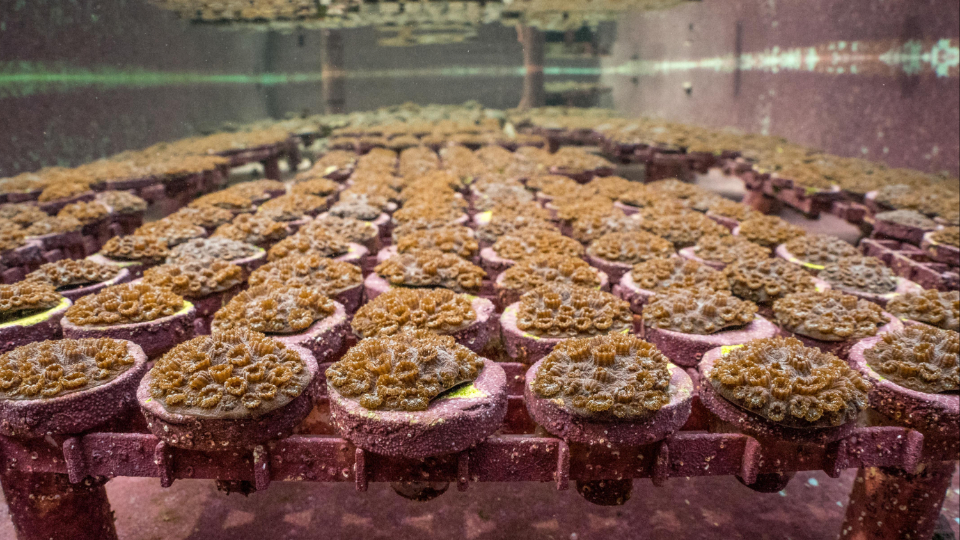
Staring into a water-filled tub lined with what looks like several gridded drip trays, it’s difficult to see what they see, but it’s all there and more. “MC-1 has a different personality,” Alicia remarked. Celia agreed and added, “MC-58 is too shy.”
Each tray has anywhere from a few to several dozen ceramic plugs, all with a specific code written on them and some with varying levels of dirt or what appears to be algae slowly taking them over. Some of these are so well-covered that the plug itself disappears.
The biologists look longingly over the aquarium below. For them, it’s not simply the contents of the aquarium that are important but the conditions as well. What is unclear at first is why any of it is important.
“We tried different foods to see which helped them grow faster,” Alicia explained. However, she’s not referring to the algae—at least, not directly.

“The codes refer to the genotype of the coral, which essentially serve as individual IDs for tracking purposes,” she added, making it quite clear that we’re not staring at a bunch of labeled and organized algae-infused pieces of ceramic. The heads of these plugs contain coral polyps, which the Mote Marine Laboratory scientists have been growing, feeding, and breeding.
“The polyps are transparent when they first ‘land’ on the plugs. It’s single-celled algae that ‘infects’ them,” Celia Leto, the Staff Coral Reproduction Biologist, explained. Leto went on to clarify that it’s the symbiotic relationship between the coral and algae that generates food for the coral through photosynthesis.
The coral are being grown to be “out-planted” in the wild in order to reproduce with diverse members of their species. But why such effort?
No matter which way one is traveling on US-1 in the Florida Keys, one might mistake the giant, brutalist building in Summerland Key as a nondescript yet out-of-place office building. The Elizabeth Moore International Center for Coral Reef Research & Restoration is one of five Mote locations in the Keys focused on saving 350 miles of Florida’s Coral Reef.
According to Alicia Manfroy, the Housing and Administrative Coordinator at the Summerland location, Mote has over 130 of these tanks specifically for studying and restoring coral on land in Florida.
Again, staring at a bunch of submerged dirty knobs or taking note of a building that looks like it could withstand most conventional weapons does not offer a lot of insight into why so much focus is being put on such a small animal, which many people would hardly even regard as an “animal.”
The point of all of this is that Florida’s coral reef—which extends from Martin County all the way down to the Dry Tortugas—is, effectively, extinct.
“We want to manage ourselves out of a job,” Manfroy explained before giving a tour of Mote’s various labs dedicated to coral restoration. She was the second person to volunteer such sentiment. Although the cynicism in such a statement seems to take itself less than seriously, it’s the dread of these scientists not managing themselves out of jobs that is far more concerning.
Since the 1970s, Florida’s reef has lost over 95% of its coral coverage. Back in 2014, the total coverage was only 6% to 7% and today stands between 1% and 2%.
The entire coral life cycle seems incredibly fragile. Sexual reproduction in the wild has also been drastically affected by declining population sizes, light pollution, ocean acidification, and changing water temperatures.

“These factors may lead to failed sexual reproduction events, which typically happen only once a year for corals,” Leto elaborated. “With the staghorn coral in our field nurseries, we have to go out and check for gametes after seasonal lunar cycles, and if present, bring the corals back to the lab on Summerland Key where we ask everyone living and working nearby to turn off their lights because corals reproduce at night, and artificial light can disrupt the process.”
For as complicated an issue as reversing extinction is, Mote’s scientists—along with the visiting international scientists housed in the dorms at the Summerland Key location—have been seeing progress in their work.
“Through a Mote pioneered technique—microfragmentation—we can get corals to grow 50-60 times faster than they would naturally grow in the wild,” Manfroy explained. “This would normally take decades to occur in the wild.”
By finding ways to “infect” coral with algae sooner, growing coral faster, out-planting genetically diverse organisms, and synchronizing reproduction, the reef may just stand a chance at a “second life.”
How did we get into this mess?
The history of Florida’s reef (or, more accurately, the demise of the reef) can be broken into two parts: before 2014 and after 2014. From the late 1970s to 2014, Florida’s reef suffered from warming water temperatures and heat-induced bleaching, increased pollution from Florida’s ever-increasing population, and destruction from more and more inbound tropical storms and hurricanes. The frequency of such storms has increased to the point that the reef’s ability to repair itself is unable to keep up.
Overfishing, boating, and dredging from coastal development have also been cited as causes for the decline.
In 2014, a new factor came into play: Stony Coral Tissue Loss Disease, or SCTLD. The disease spread throughout the entire reef in only a few years and has had devastating effects. Its cause is still not fully understood.
Today, with 98-99% of coral coverage gone, the reef is functionally extinct. At this rate, biodiverse coral species cannot compete. According to Mote researchers, one species, elkhorn coral, has less than 60 unique individuals left in the Lower Keys—not enough to successfully reproduce.
Although SCTLD is not the first major outbreak of coral disease to occur in Florida, it appears to be a novel version of the white plague, a coral disease which first appeared on the reef in the mid-1990s. However, an important difference is that, unlike its predecessor, SCTLD may not be viral. The nature of the disease was unknown initially, but recent studies have shown that after treating coral with antibiotics, disease spread has slowed.
As storms continue to batter Florida coasts and failing sewer systems overflow, however, increased amounts of bacteria are found in near-shore waters. Storms caused six sewage spills in Miami in just June 2022 alone.
How do we get out of it?
“We start with microfragmentation, where we cut off a small piece of the coral in order to ‘clone’ the genotype of that species,” explained Mote’s director of regional operations in the Florida Keys, Allison Delashmit.
Mote’s lab in Islamorada appears more rustic than the one in Summerland Key. In fact, the lab is easy to miss if one isn’t looking for it.
Located near the water’s edge at Bud N’ Mary’s Marina, most of the lab is open air, flanked by a trailer acting as a mobile workspace. Several tanks housing coral are protected only by tarps while several scientists were busy using diamond saws to cut small pieces of coral on the day of my visit.
Demonstrating on a model of a staghorn coral, Delashmit said that “fragmentation helps them grow faster. Species of the same genotype will fuse together. So, if we cut them, they grow at faster rates, and, after fusing, they can reach sexual reproduction size and reproduce on their own.”
The whole point of all this urgent work of growing, reproducing, and testing coral in labs appears to be for making babies, but where Mote differs from the average pushy in-laws is that they’re not simply looking to “grow” the reef but to ensure its diversity by getting as many unique organisms breeding as possible.

“When coral colonies of the same species are physically too far apart, or the only nearby coral is genetically identical, sexual reproduction is more likely to fail. Successful sexual reproduction depends on these populations being dense enough to support fertilization and on them being synced up to reproduce on the same night.”
Breeding genetically different individuals of the various species is not enough either: They have to be resilient to an ever-changing environment.
Back in Summerland, the Climate and Acidification Ocean Simulator, or CAOS, sits ready to test these different coral genotypes against varying conditions. Summarized as “coral boot camp,” the CAOS system can mimic field conditions, decrease pH levels and water temperatures, and can even test against forecasted conditions up to 100 years from now.
“An important aspect of managed breeding is to find a variety of stress-tolerant genotypes that can withstand various conditions,” explained Leto. “The results of these tests give us a way to quantify how genetic traits have been passed from parent colonies to offspring. This then gives us a better understanding of A) how these traits would be passed from generation to generation in nature, and B) how these corals may behave in the field, which will allow us to more effectively create a genetically diverse, restored environment.”
It is difficult to ignore the bigger picture here. The coral’s ecosystem has suffered over the last several decades as well, with many species either seeking out new shelter and feeding grounds or, as in the case of the less fortunate sea life, dying off alongside the reef itself.
“It’s not just about the coral,” Manfroy noted. “Research on what community of herbivores will work best, those that will not only help the coral survive but bring back other species, is just as important.”
Although many species that sought refuge in the reef are now over-fished and appear on all too many menus, such as stone crabs and spiny lobsters, other oft-overlooked—or less culinarily appealing—species, such as channel clinging crabs (also known as spider crabs) hold the door open for revival.
The future of Florida’s coral reef
As multiple storms blow in every year, causing countless dollars in damage and washing more pollution back out to sea, focusing on the reef seems like too localized a fight when existential crises come in the form of large ecological forces affecting (and even displacing) millions of people.

Coral reefs rarely get enough credit in these matters, however, especially when one considers that they act as natural barriers to storm surges. Florida’s reef has protected the Florida coast and people living there for centuries.
The work Mote researchers are doing has already proven itself: Restored coral populations are reproducing in the wild and organisms are surviving what they couldn’t before—including bleaching, Stony Coral Tissue Loss Disease, and Hurricane Irma.
The truly insane thing is that, in these insane times, it all makes too much sense, and what’s perhaps more is that Mote’s mission feels utopian and “impossible”—at least in the sense of overcoming so-called popular opinion, which is divided at best.
The research and results speak for themselves, but in a time when scientific study and claims to truth aren’t enough, the truly improbable task appears to be getting public support.
With scientists all over the world traveling to Summerland Key, offering up their work, and collaborating with Mote to save one of many coral reefs in dire need of saving, one thing is clear: We know it’s possible—not simply the science of reviving a reef but getting people together for the sake of collective action.
The functional extinction of Florida’s coral reef triggered a global community of scientists to come together and save an ecosystem, and to take these techniques to other areas in need, such as the Great Barrier Reef in Australia.
The only question that remains is: How do we begin this exact same work—overcoming the barrier of myth—to finally get started on the rest of the world before it’s too late?








